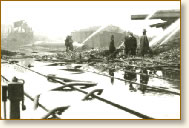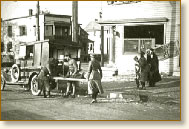Sabotage at Home
When war engulfed Europe in August 1914 President Wilson committed the United States to a strict course of neutrality. American manufacturers
 |
Explosion of munitions depot
Black Tom, NJ
July, 30, 1916 |
could trade with any of the belligerents, and as the war dragged on, America became an important source of supply, especially for munitions. By 1916, she was Britain's largest supplier of arms.
America's status as Britain's largest source of arms did not reflect an unwillingness
on her part to sell arms to Germany. Rather, Britain's blockade of Germany
prevented shipment. Unable to benefit from the American source of weapons,
Germany developed a two-pronged policy: to maintain America's neutrality and
deny as much as possible the shipment of munitions to the allies. At first,
the Germans sought to buy up existing supplies but this proved ineffective
and more direct means were employed. Black Tom, New Jersey, a staging area
for the shipment of munitions across the Atlantic, provided a tempting target.
Railroad cars, freighters and warehouses
 |
Victims of the T.A. Gillespie
munitions plant explosion
Morgan, NJ Oct. 5 1918 |
filled to capacity with explosives crammed the facility. Fire broke out in the early morning hours of July 30, 1916. An ear-splitting explosion filled the quiet night air shattering thousands of Manhattan windows across the Hudson. Drivers on the Brooklyn Bridge felt the structure sway from the shock wave. In the middle of the city the concussion burst a water main flooding a four-block area. Some suspected sabotage but many more felt the disaster due to accident,
After the war, evidence revealed that the destruction of Black Tom was a deliberate act by German saboteurs. Black Tom was only one of approximately 200 acts of German sabotage during the war years.
References:
Witcover, Jules, Sabotage at Black Tom: Imperial Germany's Secret War in America 1914-1917 (1989).
How To Cite This Article:
"Sabotage at Home" EyeWitness to History, www.eyewitnesstohistory.com (2000).
|






